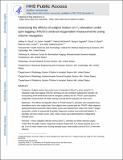Assessing the effects of subject motion on T 2 relaxation under spin tagging (TRUST) cerebral oxygenation measurements using volume navigators: Effects of Subject Motion on TRUST
Author(s)
Stout, Jeffrey N; Tisdall, M Dylan; McDaniel, Patrick; Gagoski, Borjan; Bolar, Divya S; Grant, Patricia Ellen; Adalsteinsson, Elfar; ... Show more Show less
DownloadAccepted version (975.9Kb)
Terms of use
Metadata
Show full item recordAbstract
© 2017 International Society for Magnetic Resonance in Medicine Purpose: Subject motion may cause errors in estimates of blood T2 when using the T2-relaxation under spin tagging (TRUST) technique on noncompliant subjects like neonates. By incorporating 3D volume navigators (vNavs) into the TRUST pulse sequence, independent measurements of motion during scanning permit evaluation of these errors. Methods: The effects of integrated vNavs on TRUST-based T2 estimates were evaluated using simulations and in vivo subject data. Two subjects were scanned with the TRUST+vNav sequence during prescribed movements. Mean motion scores were derived from vNavs and TRUST images, along with a metric of exponential fit quality. Regression analysis was performed between T2 estimates and mean motion scores. Also, motion scores were determined from independent neonatal scans. Results: vNavs negligibly affected venous blood T2 estimates and better detected subject motion than fit quality metrics. Regression analysis showed that T2 is biased upward by 4.1 ms per 1 mm of mean motion score. During neonatal scans, mean motion scores of 0.6 to 2.0 mm were detected. Conclusion: Motion during TRUST causes an overestimate of T2, which suggests a cautious approach when comparing TRUST-based cerebral oxygenation measurements of noncompliant subjects. Magn Reson Med 78:2283–2289, 2017. © 2017 International Society for Magnetic Resonance in Medicine.
Date issued
2017Department
Harvard University--MIT Division of Health Sciences and Technology; Massachusetts Institute of Technology. Institute for Medical Engineering & Science; Massachusetts Institute of Technology. Department of Electrical Engineering and Computer ScienceJournal
Magnetic Resonance in Medicine
Publisher
Wiley
Citation
Stout, J. N., et al. "Assessing the Effects of Subject Motion on T2 Relaxation under Spin Tagging (Trust) Cerebral Oxygenation Measurements Using Volume Navigators." Magn Reson Med (2017).
Version: Author's final manuscript